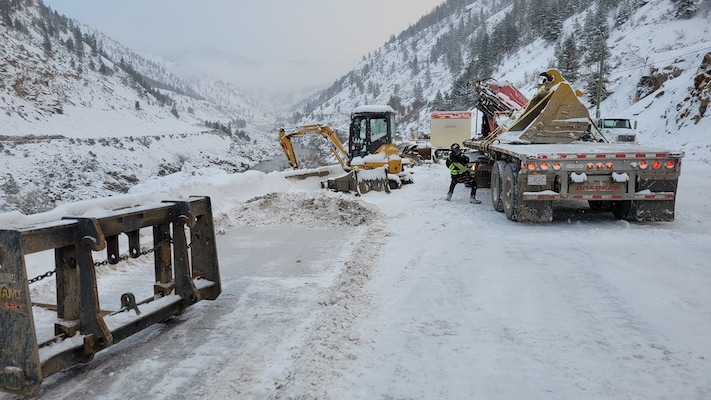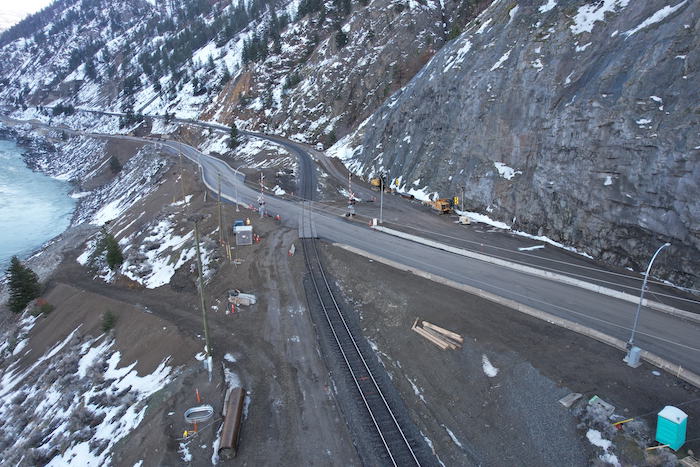
2023 #CCEAwards Showcase: Tank Hill Emergency Restoration
November 2, 2023
By CCE
“They had to make a lot of critical decisions quickly—and did so exceptionally well.” – Jury
Category: Transportation
Award of Excellence Winner: AECOM
After severe storms hit southwestern British Columbia in November 2021, dropping a month’s worth of rain in 48 hours, AECOM provided emergency assistance to the province’s ministry of transportation and infrastructure to reinstate the Trans-Canada Highway at the Tank Hill underpass, where a road and rail grade separation was destroyed, near the village of Lytton, B.C.
With funding from the federal government under the Disaster Financial Assistance Arrangements (DFAA) program, AECOM quickly and safely mobilized a team that worked around-the-clock in the coldest weather to hit the region in years. What would typically take months was successfully completed in eight weeks. The road reopened in January 2022.
An immediate response
The fierce rains on Nov. 14 and 15, 2021, caused extreme flooding and mudslides and, in turn, catastrophic destruction and road closures throughout the region. Among the extensive damage was the complete washout of a 100-m stretch on the Trans-Canada Highway at the Tank Hill underpass, which destroyed both road and Canadian Pacific (CP) rail infrastructure.
A portion of the roadway and much of the rail bridge fill east of the bridge were completely washed away. The railway overpass structure, however, stayed in place on what remained of the exposed and battered piles.
Following the storm, AECOM was called on Nov. 20 to provide emergency assistance to help reinstate the washed-out grade of the highway and to design an interim road and at-grade railroad crossing to replace the unsalvageable grade separation structure.
AECOM immediately began assembling its team and began design work by the following morning. By Nov. 22, AECOM staff were on-site. Soon, a diverse team of more than 70 specialists from 10 different offices was hard at work on repairing this vital road link between Vancouver and the rest of Canada.
On Nov. 23, the team presented two design options, complete with plan and profile, ready for review by the ministry of transportation and infrastructure. By this time, on-site AECOM staff were already supporting the reconstruction and working collaboratively with multiple contractors.
AECOM’s team was focused on developing an interim alignment for a functional highway and new at-grade railway crossing. This work included highway geometrics design, geotechnical engineering, hydrology analysis and drainage updates, traffic engineering (including railway pre-emption timing for new highway signals), riverbank protection design and engineering services during construction.
Meeting the challenge
To meet the unusual demands of this project, AECOM mobilized a team of specialists and senior staff from across Western Canada, with the specific skills needed to respond to on-site issues as they occurred, so as to reinstate the corridor as quickly and as safely as possible.
As prime consultant, AECOM co-ordinated a team of seven subconsultants. The project evolved from emergency response to design to construction. While work progressed, challenges continued to emerge, including complex drainage and hydrology requirements, as well as the need to manage surrounding grade instabilities during construction. Also, access to the site was compromised by other nearby washouts.

The team worked around-the-clock in the coldest weather to hit the region in years. Photo courtesy AECOM.
Streamlined processes and emergency response guidelines were implemented to facilitate immediate review and resolution of such issues. Staff worked on-site in 24-hour shifts, seven days per week, through rain and snow.
The team included project managers, field staff, geotechnical and rock mechanics, road engineers, rail bridge engineers and other rail specialists from British Columbia, Alberta, Saskatchewan, Manitoba and Ontario. Hydrotechnical and climate specialists were also brought in from Manitoba and Quebec.
With the complete destruction of the roadway and railway infrastructure at the Tank Hill underpass, local travel in neighbouring communities and the movement of goods and services through the area—including to the Port of Vancouver—became extremely challenging, if not impossible. Quickly reinstating this portion of the highway and railroad crossing were critical to the well-being of residents and workers.
The Tank Hill washout was only one of many that sliced through the Trans-Canada Highway, effectively isolating some communities from services at the larger hub of Kamloops, B.C. These same communities had been stricken by wildfires only months earlier; Lytton was virtually wiped out by a wildfire in 2021 and would suffer again in 2022.
AECOM’s ability to quickly assemble and mobilize a team of specialists with the required expertise enabled the rapid response needed to get emergency road and railway repairs underway and promptly restore connectivity between communities.
Preparing for the future
As part of the design, the team incorporated sustainability and climate resilience elements to prevent potential issues and recurrence of similar devastation in future extreme weather events. The recent forest fires and floods in the area had changed the canyon’s existing hydraulic flows and capacities, which directly impacted the runoff at Tank Hill. Enhancements were made to expand the culvert and hydraulic emergency capacity to better manage newly predicted flows.
The team also added a catchment system to prevent debris and other material from flowing down the mountain and blocking culverts. This new catchment was shotcreted to prevent rocks and trees from impeding water flow and to avoid any buildup that could potentially cause another washout of the roadway and railway tracks. AECOM’s team recommended a water level monitoring system for the catchment basin, which was implemented by CP Rail under a separate contract.
Reopening the route
The affected portion of the Trans-Canada Highway reopened on Jan. 14, 2022, just eight weeks after the original washout.
“We all owe a huge debt of gratitude to all of the crews and staff who have put in long hours to make the repairs necessary to reopen Highway 1 through the Fraser Canyon,” said Rob Fleming, British Columbia’s minister of transportation and infrastructure, upon the reopening. “The construction and engineering accomplishments to get people and goods moving again after the highway sustained such heavy damage are nothing short of remarkable.”
Tank Hill Emergency Restoration, Lytton, B.C.
Award-winning firm (prime consultant): AECOM, Burnaby, B.C. (Pat Cruickshank, MBA, P.Eng.; David Smith, P.Eng.; Kulwinder Phul, Civil Tech; Eric Smith; Imran Gehlen, P.Eng.; Kenn Leonhardt, P.Eng., PE, PMP; Faris Alobaidy, P.Eng.; Kaz Eskoch, P.Eng.; Giovanni Jaya E.I.T.).
Owner: British Columbia Ministry of Transportation & Infrastructure.
Other key players: Tetra Tech (on-site ministry representative), Thurber Engineering (ministry geotechnical engineering representative), Great Northern Engineering Consultants (GNEC) (electrical engineering), Underhill Geomatics (survey and drone imaging), Ecotope (environmental and drone imaging), Van Bower (survey and site supervision), Northwest Hydraulic Consultants (NHC) (hydrology monitoring), Brentwood Enterprises, Sacchetti Heavy Civil Construction, Dawson Civil, Formula Contractors.
